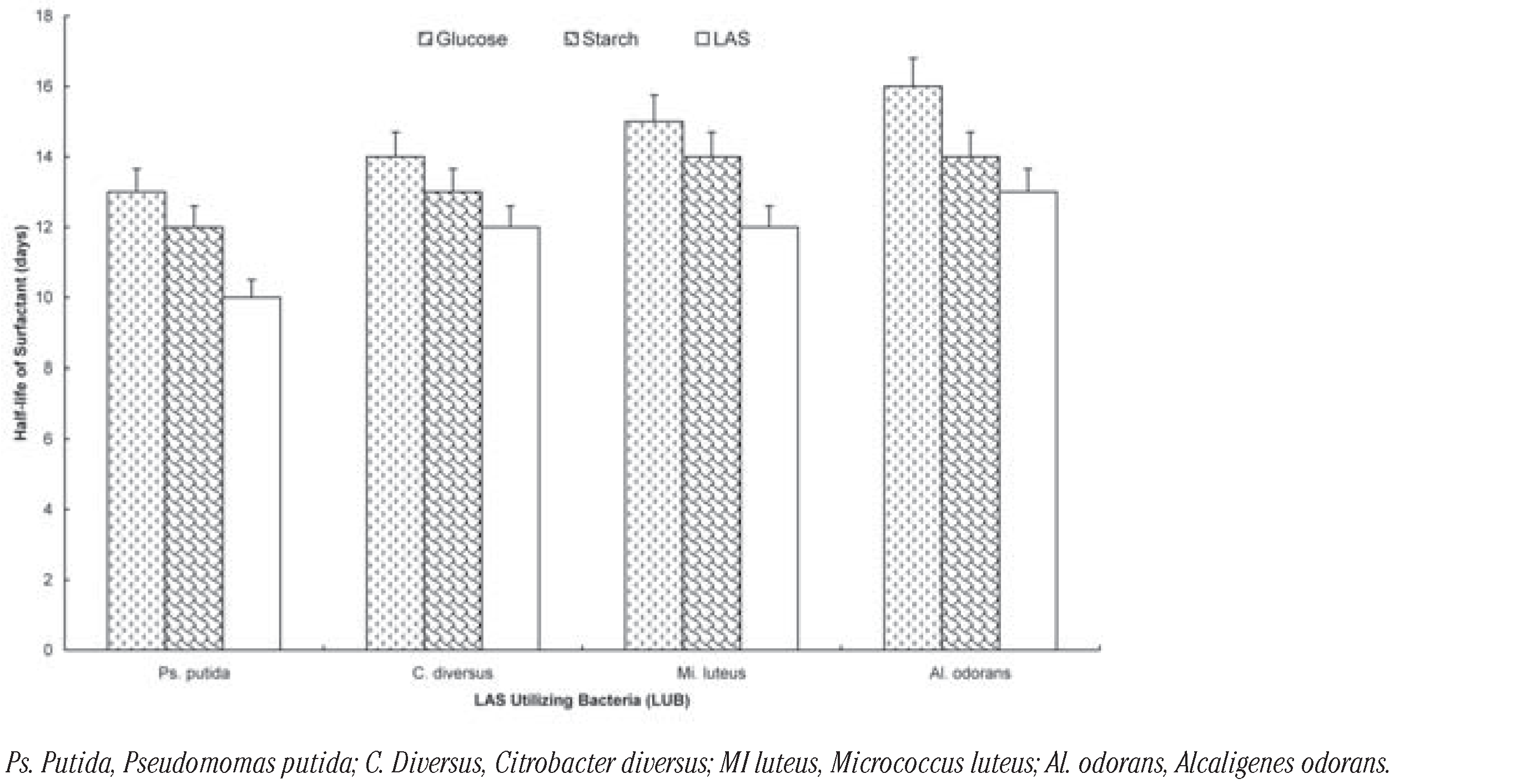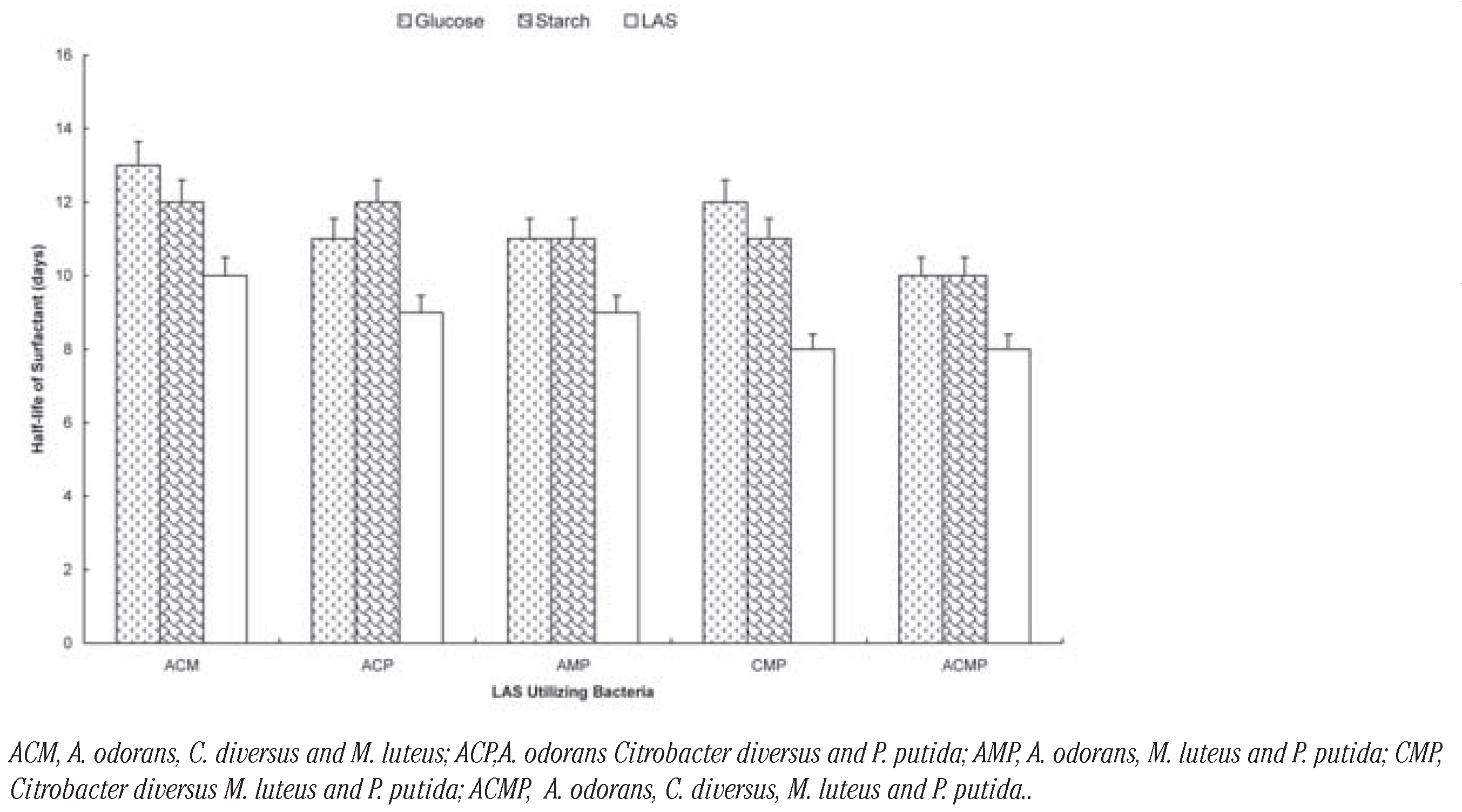Effect of Additional Carbon Source on Biodegradation of Linear Alkylbenzene Sulfonate by Las-Utilizing Bacteria
Abstract
Introduction
Materials and Methods
Selection of organims
Degradation studies
Results
Discussion
Conclusions
References
- Abel, P.D. Detergents. In Water Pollution Biology, 2nd ed.; Taylor and Francis Ltd.: London, 2002; pp. 63–65. [Google Scholar]
- Houston, C.A. Detergents: Changing Expectation, Content. Inform 1997, 8, 928–38. [Google Scholar]
- WHO. International Programme on Chemical Safety. Environmental health criteria 169. Linear alkylbenzene sul fonates and related compounds; World Health Organization: Geneva, Switzerland, 1996. [Google Scholar]
- Anderson, D.J.; Day, M.J.; Russell, N.J.; White, G.F. Temporal and geographical distribution of epilitic sodium dodecyl sulfatesdegrading bacteria in a polluted South Wales river. Appl Environ Microbiol 1988, 54, 555–60. [Google Scholar] [CrossRef] [PubMed]
- Cook, A.M.; Hrsak, D. The complete degradation of LAS is becoming better understood with pure cultures of bacteria. The CLER Review 2000, 6, 46–53. [Google Scholar]
- Dong, W.; Eichhorn, P.; Radajewski, S.; et al. Parvibaculum lavamentivorans converts linear alkylbenzenesulphonate to sulphophenylcarboxylates, alpha, beta- unsaturated sulphophenylcarboxylates and sulphophenyldicarboxylates, which are degraded in communities. J Appl Microbiol 2004, 96, 630–40. [Google Scholar] [CrossRef] [PubMed]
- Cavalli, L.; Cassani, G.; Maraschin, C. Structural Elucidation of Linear Alkylbenzene Sulfonate (LAS) biodegradation Intermediates. The CLER Review 1996, 2, 4–13. [Google Scholar]
- Eniola, K.I.T.; Olayemi, A.B. Linear Alkylbenzene Sulfonate tolerance in bacte- ria isolated from sediment of tropical water bodies polluted with detergents. Rev Biol Trop 2008, 56, 1595–601. [Google Scholar] [PubMed]
- Ogunseitan, O.A. Removal of caffeine in sewage by Pseudomonas putida: Implication for water pollution index. World J Microbiol Biotechnol 1996, 12, 251–6. [Google Scholar] [CrossRef] [PubMed]
- Mettler Toledo. Turbidimetric titration: Determination of anionic surfactants / M603. 2011. Available from: http://it.mt.com/it/it/home/supportive_content/application_editorials.M603.titrationEd.html.
- Clarke, P.H. Microbiology and Pollution: The biodegrdation of Natural and synthetic compounds. Phil Transf R Soc Lond 1980, 290, 355–67. [Google Scholar]
- Holtel, A.; Marques, S.; Mohler, I.; et al. Carbon source dependent inhibition of xyl operon expression of Pseudomonas putida TOL plasmid. J Bacteriol 1994, 176, 1773–6. [Google Scholar] [CrossRef] [PubMed][Green Version]
- O’Connor, K.; Buckley, C.M.; Hartmans, S.; Dobson, A.D. Possible regulatory role for non aromatic carbon source in styrene degradation by Pseudomonas putida CA-3. Appl Environ Microbiol 1995, 61, 544–8. [Google Scholar] [CrossRef] [PubMed]
- Sanz, J.L.; Culubret, E.; de Ferrer, J.; et al. Anaerobic degradation of linear alkylbenzene sulfonate (LAS) in upflow anaerobic sludge blanket (USAB). Biodegradation, 2003; 14, 57–64. [Google Scholar]
- Bajaj, M.; Callert, C.; Winter, J. Effect of Co-Substrates on Aerobic Phenol Degradation by Acclimatized and Non-acclimatized Enrichment Cultures. Eng Life Sci 2008, 8, 125–31. [Google Scholar] [CrossRef]
- Shimp, R.; Pfeander, F.K. Influence of easily degradable naturally occurring carbon substrate on biodegradation of monosubstituted phenols by aquatic bacteria. Appl Environ Microbiol, 1985; 49, 394–401. [Google Scholar]
- Eniola, K.I.T.; Olayemi, A.B. Utilization of detergent surfactant by bacteria isolated from freshwater bodies. Nig J Microbiol 2000, 14, 49–53. [Google Scholar]
- Bollag, W.B.; Bollag, J. Biodegradation. Encyclopedia of Microbiology; Academic Press: London, UK, 1992; Vol. 1, pp. 269–276. [Google Scholar]
- Hardman, D.J. Microbial Control of Environmental Pollution: The use of Genetic Techniques to Engineer Organisms with Novel Catalytic Capabilities. In Environmental Biotechnology; Forster, C.F., John Wase, D.A ., Eds.; Ellis Horwood Ltd.: London, England, 1989; pp. 295–317. [Google Scholar]
- Schoberl, P. Basic principles of LAS biodegradation. Tenside Deterg 1989, 26, 86–94. [Google Scholar] [CrossRef]
- Yediler, A.; Zhang, Y.; Cai, J.P.; Korte, F. Effect of the microbial population size on the degradation of linear alkylbenzene sulfonate in lake water. Chemosphere 1989, 18, 1589–97. [Google Scholar] [CrossRef]
- Dentel, S.K.; Allen, H.E.; Srinivasarao, C.; Divincenzo, J. Effects of surfactants on sludge dewatering and pollutant fate; Third year completion report project number; Water Resources Center. University of Delaware: Delaware, USA, 1993. [Google Scholar]



Disclaimer/Publisher’s Note: The statements, opinions and data contained in all publications are solely those of the individual author(s) and contributor(s) and not of MDPI and/or the editor(s). MDPI and/or the editor(s) disclaim responsibility for any injury to people or property resulting from any ideas, methods, instructions or products referred to in the content. |
© Copyright K.I.T. Eniola, 2011 Licensee PAGEPress, Italy. This work is licensed under a Creative Commons Attribution NonCommercial 3.0 License (CC BY-NC 4.0).
Share and Cite
Eniola, K.I.T. Effect of Additional Carbon Source on Biodegradation of Linear Alkylbenzene Sulfonate by Las-Utilizing Bacteria. J. Xenobiot. 2011, 1, e2. https://doi.org/10.4081/xeno.2011.e2
Eniola KIT. Effect of Additional Carbon Source on Biodegradation of Linear Alkylbenzene Sulfonate by Las-Utilizing Bacteria. Journal of Xenobiotics. 2011; 1(1):e2. https://doi.org/10.4081/xeno.2011.e2
Chicago/Turabian StyleEniola, Kehinde I. Temitope. 2011. "Effect of Additional Carbon Source on Biodegradation of Linear Alkylbenzene Sulfonate by Las-Utilizing Bacteria" Journal of Xenobiotics 1, no. 1: e2. https://doi.org/10.4081/xeno.2011.e2
APA StyleEniola, K. I. T. (2011). Effect of Additional Carbon Source on Biodegradation of Linear Alkylbenzene Sulfonate by Las-Utilizing Bacteria. Journal of Xenobiotics, 1(1), e2. https://doi.org/10.4081/xeno.2011.e2



